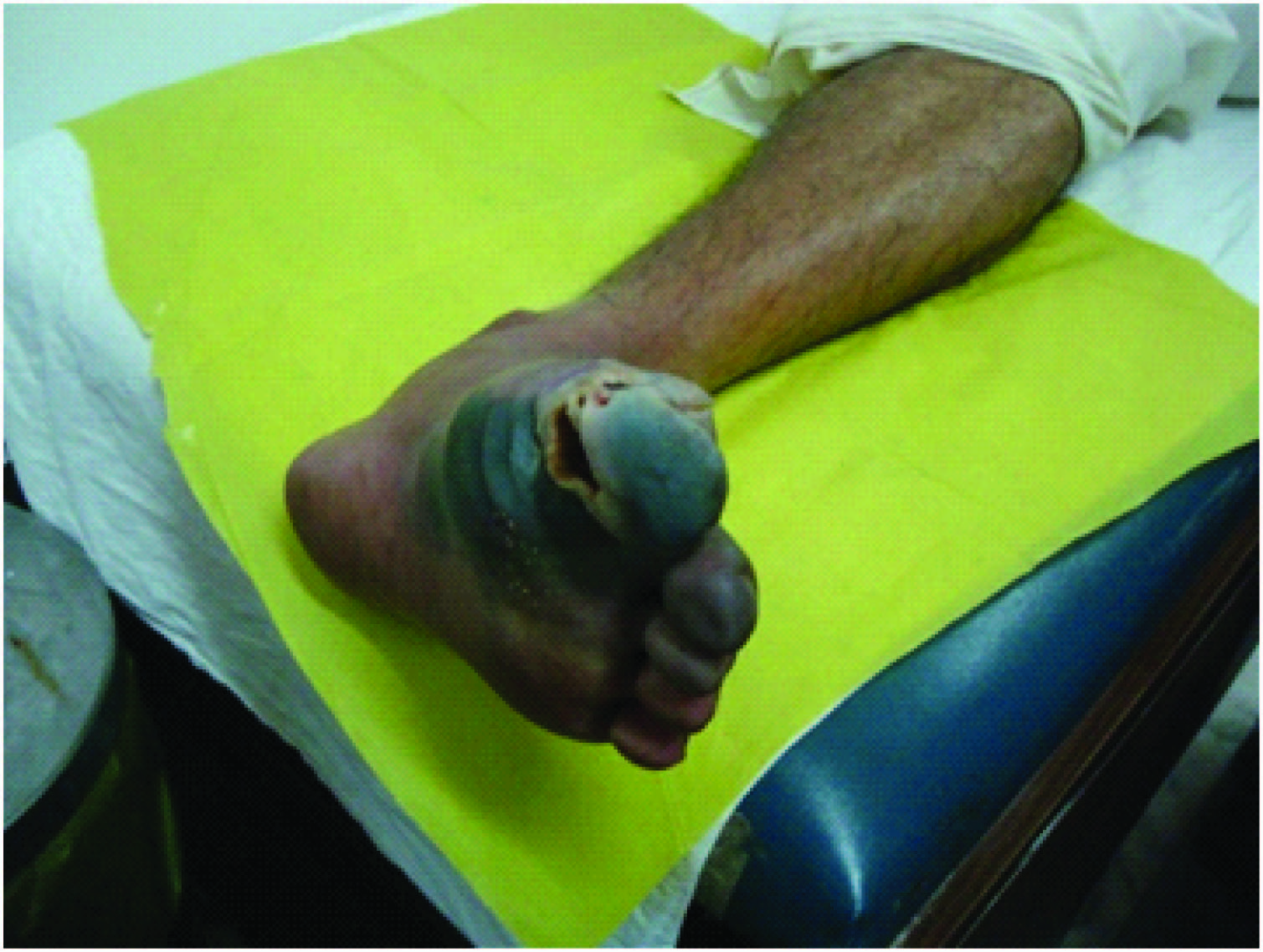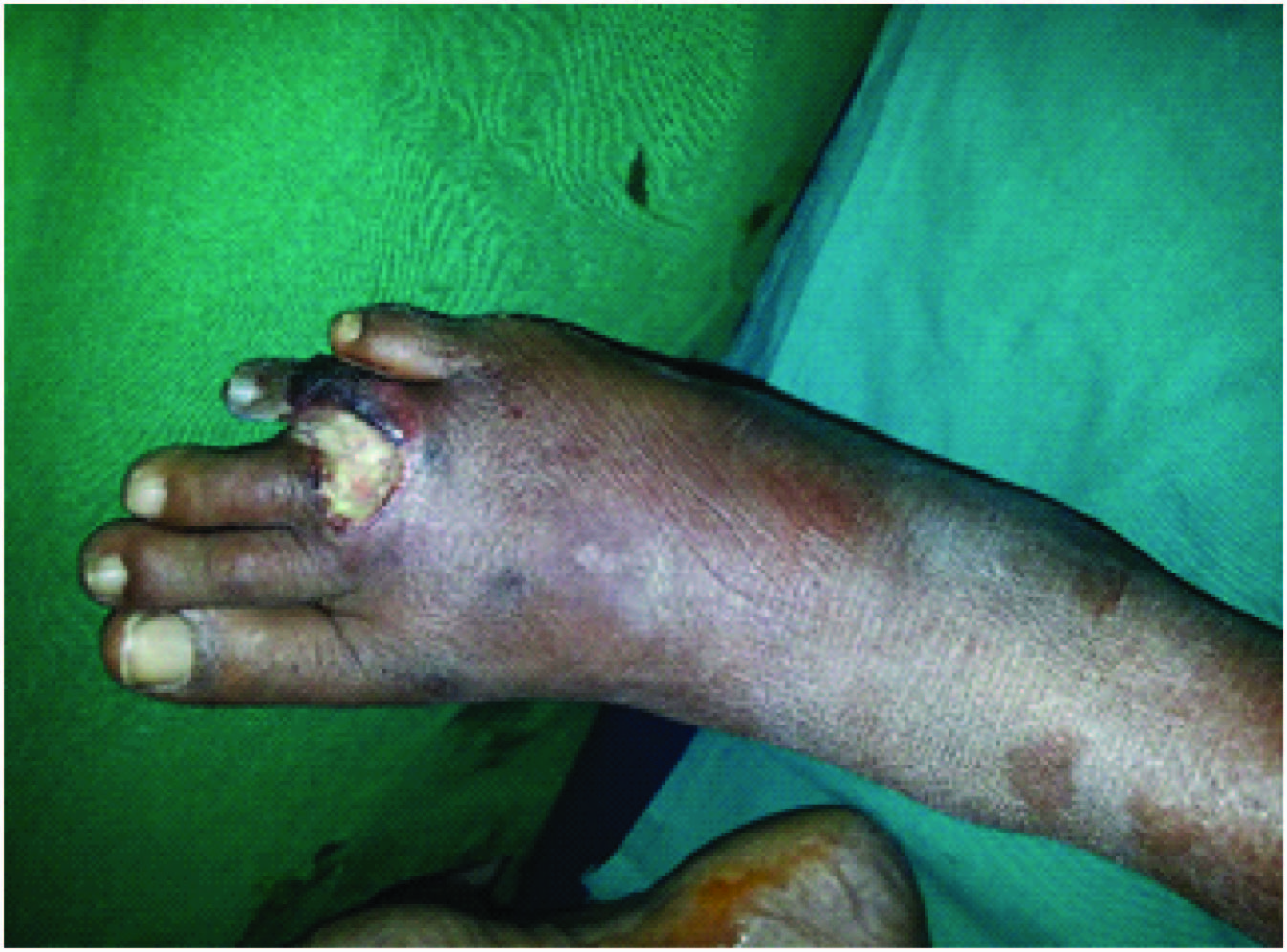Evaluation of Diabetic Foot Complications According to Amit Jain’s Classification
Kalaivani V1
1 Associate Professor, Department of General Surgery, M S Ramaiah Medical College, Bangalore, Karnataka, India.
NAME, ADDRESS, E-MAIL ID OF THE CORRESPONDING AUTHOR: Dr. Kalaivani V, #20/1, Payappa Garden, Tasker Town, Queen’s Road Down, Bangalore, Karnataka - 560051, India. Phone : 9945090285, E-mail : dr.vani_rajan@yahoo.com
Background : Wagners classification has been one of the commonly used grading system for diabetic foot lesions. Amit Jain’s classification is a new classification which includes almost all the common problems affecting diabetic foot. The aim of our study was to include the patients with Diabetic foot in different sub groups as per the new classification and to evaluate the outcome.
Materials and Methods: This retrospective study was conducted by analyzing the records of the inpatients in the Department of Surgery in a tertiary care teaching institute at Bangalore, India, between June 2013 to December 2013.
Results : Males (82.11%) were more commonly affected than females, the ratio being 4.6:1. Type 1 diabetic foot complications (91.06%) were the most common type of diabetic foot complication seen at our centre. Wet gangrene (35.7%) was the most common type of type 1 diabetic foot complication. Twenty (16.26%) patients underwent major amputations out of which 12.2% belonged to type 1 complications.
Conclusion: Majority of the diabetic foot patients in a tertiary care hospital belonged to type 1 complication. Most of the major amputations in a diabetic occurred in type 1 diabetic foot complication. This classification was found to be very easy and almost all the diabetic foot complications were placed effectively and appropriately in this classification.
Introduction
Diabetes mellitus is a major public health problem and so is its complication, the diabetic foot (DF). It is one of the most common reasons for hospitalization in diabetic patients accounting for around 25% of all diabetes related admissions in the United States [1]. Diabetic foot disease is known to have major medical, social and economic consequences [2]. It is estimated that annually 2% of all diabetic patients will develop a foot ulcer and around 15% of them willl ulcerate during their lifetime [3].
Diabetic foot lesions are commonly classified according to Wagner’s classification [2]. There are various studies on this classification [2,4,5]. Amit Jain’s classification [Table/Fig-1][6,7] for diabetic foot is a new classification that includes all the common complications of diabetic foot, is simple and easy to remember.
Showing Amit Jain’s classification of diabetic foot complications
| Sl No | Type of Complications | Lesions |
|---|
| 1] | Type 1 [Infective] | Cellulitis, Wet Gangrene, Necrotizing Fasciitis, Abscess, Etc |
| 2] | Type 2 [Noninfective] | Non Healing Ulcers, Peripheral Arterial Disease, Entrapment Neuropathies, Hammer toes, Claw toes, Diabetic Neuro-osteoarthropathy, Etc |
| 3] | Type 3 [Mixed] | Example - Non healing ulcer With Osteomyelitis |
The Aim of this study is to include the patients with diabetic foot complications to various sub groups of Amit Jain’s classification and evaluate the results.
Materials and Methods
The records of the inpatients admitted to the Department of General Surgery in a tertiary care teaching hospital were retrospectively analysed. The study period was from June 2013 to December 2013. The following were the inclusion and exclusion criteria;
Inclusion criteria
All type 2 diabetes patients,
Inpatients admitted and treated during this period in our department,
Patients referred to general surgery department, from other departments/ institutions for further management.
Exclusion criteria
All outpatients,
Lesions in the lower limb that spares foot,
Healing diabetic foot ulcers planned for skin grafting,
All non diabetics.
Results
There were 123 patients who were included in this study during this period. There were 101 males (82.11%) and 22 females (17.89%), the male: female ratio being 4.6:1. One hundred tweleve patients (91.06%) were affected with type 1 diabetic foot complication, 3 patients (2.44%) with type 2 and 8 patients (6.5%) with type 3 diabetic foot complications [Table/Fig-2]. Majority of the males (74.8%) were affected with type 1 diabetic foot complications.Fifty three patients (43.09%) had right foot involvement and 70 patients (56.91%) had left foot involved. Only one patient had both the feet involved.
Showing distribution of cases according to Amit Jain’s classification
| Sl No | Type of diabetic foot complications | Number | Percentage |
|---|
| 1 | Type 1 complications | 112 | 91.06% |
| 2 | Type 2 complications | 03 | 2.44% |
| 3 | Type 3 complications | 08 | 6.5% |
| Total | 123 | 100% |
Wet gangrene (35.7%) was the most common type 1 diabetic foot complication [Table/Fig-3,4] followed by necrotizing fasciitis (27.67%). Overall, debridement (53.65%) was the most commonly performed procedure [Table/Fig-5]. It was also the most common surgical procedure done in type I complications followed by toe amputations.
Showing different types of type 1 diabetic foot complications
| Sl No | Type of diabetic foot complications | Number | Percentage |
|---|
| 1] | Wet gangrene | 40 | 35.7% |
| 2] | Necrotizing fasciitis | 31 | 27.67% |
| 3] | Abscesses | 16 | 14.29% |
| 4] | Infected ulcers | 22 | 19.64% |
| 5] | Osteomyelitis | 03 | 2.68% |
| Total | 112 | 100% |
Showing wet gangrene of the left foot. It is type 1 diabetic foot complication

Showing distribution of different procedures according to Amit Jain’s classification of diabetic foot complications
| Sl No | Management | Type 1 | Type 2 | Type 3 | Total | Percentage |
|---|
| 1] | Debridement/I&D | 64 | - | 2 | 66 | 53.66% |
| 2] | Toe amputation/ disarticulation | 28 | - | 3 | 31 | 25.20% |
| 3] | Transmetatarsal amputation | 5 | - | 1 | 6 | 4.88% |
| 4] | Below knee amputation | 12 | 2 | 2 | 16 | 13.01% |
| 5] | Above knee amputation | 3 | 1 | - | 4 | 3.25% |
| TOTAL | 112 | 3 | 8 | 123 | 100% |
Among the three patients belonging to type 2 DF complications, two patients had peripheral arterial disease with extensive gangrene and the third patient had ischaemic heal ulcer, which was not salvageable. Eight patients belonged to type 3 complications [Table/Fig-6],six patients had non healing infected ulcer with osteomyelitis, three of whom underwent toe amputation, two debridements and one metatarsal amputation. The remaining two patients underwent major amputations due to mixed complications consisting of infective gangrene, deformed foot associated with peripheral arterial disease. In this study, 20 patients (16.26%) underwent major amputations out of which 15 patients (12.2%) were having type I diabetic foot complications. There was one death in a patient with necrotising fasciitis in our study.
Showing a case of type 3 diabetic foot complication. Patient had non healing ulcer with infective gangrene and underlying peripheral vascular disease

Discussion
Diabetic foot is one of the most dreaded complications of diabetes as it may lead to amputation, a devastating consequence [8]. The burden of diabetic foot ulceration is heaviest in the resource poor parts of the world where the incidence is quite high [9].
Wagner’s classification has been used commonly to describe the diabetic foot ulcers [2,4,9] which is based on wound depth and the extent of tissue necrosis. Several authors have noted a disadvantage of this system, that it only accounts for wound depth and appearance and does not consider the presence of ischaemia or infection [10,11]. University of Texas Classification though includes ischaemia and infection it does not include any other DF complications like Necrotising fasciitis and Osteomyelitis.
The new Amit Jain’s classification was chosen as it includes almost all DF complications [6,7]. Our study shows that type 1 diabetic foot complications are the most common type of complications seen in the hospitalized patients. Statistics show that around 40% of inpatients admitted with diabetic foot problems, will require some form of amputation [12]. In our study, 46.34% required some form of amputation, with toe amputation being the commonest amputation. 16.26% of the patients required major amputations which is comparable with a rate of 9-24% in the literature [5,13].
Comparing our study with Jain et al., series [14], wet gangrene was the most common type 1 diabetic foot complication and 12.2% of the major amputations occurred in this group. while, abscess was the commonest type 1 diabetic foot complications in Jain et al., series, and 8.89% of the patients underwent major amputations in this group [7].
Majority of the patients (n=112) belonged to type 1 DF complication, 13.39% patients underwent major amputation, with one death in the patient with NF, in this group. 25% of patients underwent major amputation in type 3 while all the three patients [100%] belonging to type 2, underwent major amputation though there were no amputations in type 2 and 3 patients in the Jain et al., series [14].
Amit Jain’s classification could thus include all the diabetic foot complications in the various subgroups, that were encountered during the study period in a simplified way. It could possibly be a good teaching and communicative tool and may help in timing the management.
Conclusion
In our study, as per Amit Jain’s classification type 1 diabetic foot complications were the most common complication encountered by the treating surgeon. Debridement was the most common procedure performed in type 1 complication followed by toe amputation. Major amputations occurred more frequently in type 1 diabetic foot complications. As this is a new classification, few more studies will be required to predict the clinical outcome.
[1]. Suliman MO, Salim OE, Ahmed ME, Major lower limb amputations in diabetics KMJ 2012 5(1):694-98. [Google Scholar]
[2]. Shah SF, Hameed S, Evaluation and management of diabetic foot: A multicentric study conducted at Rawalpindi, Islamabad Ann Pak Ins Med Sci 2011 7(4):233-37. [Google Scholar]
[3]. Eskelinen E, Eskelinen A, Alback A, Lepantalo M, Major amputation incidence decreases both in nondiabetic and in diabetic patients in Helsinki Scand J Surg 2006 95:185-89. [Google Scholar]
[4]. Muquim RU, Griffin S, Ahmed M, Evalutation and management of diabetic foot according to wagner’s classification- A study of 100 cases J Ayub Med Coll Abbottabad 2003 15(3):39-42. [Google Scholar]
[5]. Adam Ma, Hamza AA, Ibrahim AE, Diabetic septic foot in Omdurman teaching hospital Sudan JMS 2009 4(2):129-32. [Google Scholar]
[6]. Jain AKC, A new classification of diabetic foot complications: A simple and effective teaching tool J Diab Foot Comp 2012 4(1):1-5. [Google Scholar]
[7]. Jain AKC, Joshi S, Diabetic foot classifications: Review of literature Medicine science 2013 2(3):715-21. [Google Scholar]
[8]. Veves A, Giurini JM, Logerfo FW, In: The diabetic foot- medical and surgical management 2012 3rd edUSAHumana press [Google Scholar]
[9]. Chalya PL, Mabula JB, Surgical management of diabetic foot ulcers: A Tanzanian university teaching hospital experience BMC Research notes 2011 4:365 [Google Scholar]
[10]. Boulton AI, Armstrong DG, Albert SF, Frykberg RG, Hellman R, Kirkman MS, Comprehensive foot examination and risk assessment Diabetes Care 2008 31:1679-85. [Google Scholar]
[11]. Frykberg RG, Diabetic foot ulcers: pathogenesis and management Am Fam Phys 2002 66:1655-62. [Google Scholar]
[12]. Singh G, Chawla S, Amputation in diabetic patients MJAFI 2006 52:36-39. [Google Scholar]
[13]. Altunbas H, Balci MK, Karayalan U, A retrospective analysis of hospitalized diabetic foot patients in Akdeniz university school of medicine, Division of Endocrinology Turk J Endo Met 1999 3:123-27. [Google Scholar]
[14]. Jain AKC, Viswanath S, Distribution and analysis of diabetic foot OA Case Reports 2013 2(12):117 [Google Scholar]